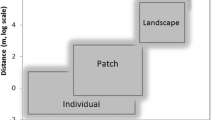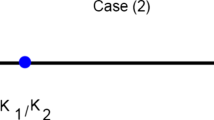Abstract
How to scale up from local-scale interactions to regional-scale dynamics is a critical issue in field ecology. We show how to implement a systematic approach to the problem of scaling up, using scale transition theory. Scale transition theory shows that dynamics on larger spatial scales differ from predictions based on the local dynamics alone because of an interaction between local-scale nonlinear dynamics and spatial variation in density or the environment. Based on this theory, a systematic approach to scaling up has four steps: (1) derive a model to translate the effects of local dynamics to the regional scale, and to identify key interactions between nonlinearity and spatial variation, (2) measure local-scale model parameters to determine nonlinearities at local scales, (3) measure spatial variation, and (4) combine nonlinearity and variation measures to obtain the scale transition. We illustrate the approach, with an example from benthic stream ecology of caddisflies living in riffles. By sampling from a simulated system, we show how collecting the appropriate data at local (riffle) scales to measure nonlinearities, combined with measures of spatial variation, leads to the correct inference for dynamics at the larger scale of the stream. The approach provides a way to investigate the mechanisms and consequences of changes in population dynamics with spatial scale using a relatively small amount of field data.





Similar content being viewed by others
References
Bolker B, Pacala SW (1997) Using moment equations to understand stochastically driven spatial pattern formation in ecological systems. Theor Popul Biol 52:179–197
Bolker BM, Pacala SW (1999) Spatial moment equations for plant competition: understanding spatial strategies and the advantages of short dispersal. Am Nat 153:575–602
Carroll RJ, Ruppert D, Stefanski LA (1995) Measurement Error in Nonlinear Models. Chapman & Hall, New York
Chesson P (1978) Predator-prey theory and variability. Ann Rev Ecol Syst 9:323–347
Chesson P (1996) Matters of scale in the dynamics of populations and communities. In: Floyd RB, Sheppard AW, De Barro PJ (eds) Frontiers of population ecology. CSIRO Publishing, Melbourne, pp 353–368
Chesson P (1998a) Making sense of spatial models in ecology. In: Bascompte J, Solé RV (eds) Modeling spatiotemporal dynamics in ecology. Landes Bioscience, Austin, pp 151–166
Chesson P (1998b) Spatial scales in the study of reef fishes: a theoretical perspective. Aust J Ecol 23:209–215
Chesson P (2000) General theory of competitive coexistence in spatially-varying environments. Theor Popul Biol 58:211–237
Chesson P (2001) Metapopulations. In: Levin SA (ed) Encyclopedia of biodiversity, Volume 4. Academic, San Diego, pp 161–176
Chesson P, Donahue MJ, Melbourne BA, Sears AL (2005) Scale transition theory for understanding mechanisms in metacommunities. In: Holyoak M, Leibold MA, Holt RD (eds) Metacommunities: Spatial dynamics and ecological communities. University of Chicago Press, Chicago
Clark SJ, Perry JN, Marshall EJP (1996) Estimating Taylor’s power law parameters for weeds and the effect of spatial scale. Weed Res 36:405–417
De Jong G (1979) The influence of the distribution of juveniles over patches of food on the dynamics of a population. Neth J Zool 29:33–51
Downes BJ, Lake PS, Glaister A, Webb JA (1998) Scales and frequencies of disturbances: rock size, bed packing and variation among upland streams. Freshwater Biol 40:625–639
Englund G, Cooper SD (2003) Scale effects and extrapolation in ecological experiments. Adv Ecol Res 33:161–213
Feller W (1971) An introduction to probability theory and its applications. Vol. 2, Second edn. Wiley, New York
Hanski I, Simberloff D (1997) The metapopulation approach, its history, conceptual domain, and application to conservation. In: Hanski I, Gilpin ME (eds) Metapopulation biology: ecology, genetics, and evolution. Academic, San Diego, pp 5–26
Hassell MP, May RM, Pacala SW, Chesson PL (1991) The persistence of host-parasitoid associations in patchy environments. 1. A general criterion. Am Nat 138:568–583
Hilborn R, Mangel M (1997) The ecological detective: confronting models with data. Princeton University Press, Princeton, New Jersey
Hughes JM, Bunn SE, Hurwood DA, Cleary C (1998) Dispersal and recruitment of Tasiagma ciliata (Trichoptera: Tasimiidae) in rainforest streams, south-eastern Australia. Freshwater Biol 39:117–127
Ives AR (1988) Covariance, coexistence and the population dynamics of two competitors using a patchy resource. J Theor Biol 133:345–361
Jackson JK, McElravy EP, Resh VH (1999) Long-term movements of self-marked caddisfly larvae (Trichoptera: Sericostomatidae) in a California coastal mountain stream. Freshwater Biol 42:525–536
Kohler SL (1992) Competition and the structure of a benthic stream community. Ecol Monogr 62:165–188
Kohler SL, Wiley MJ (1997) Pathogen outbreaks reveal large-scale effects of competition in stream communities. Ecology 78:2164–2176
Lloyd M (1967) Mean crowding. J Anim Ecol 36:1–30
Lloyd M, White J (1980) On reconciling patchy microspatial distributions with competition models. Am Nat 115:29–44
Marchant R, Hehir G (1999) Growth, production and mortality of two species of Agapetus (Trichoptera: Glossosomatidae) in the Acheron River, south-east Australia. Freshwater Biol 42:655–671
Melbourne BA, Sears AL, Donahue MJ, Chesson P (2005) Applying scale transition theory to metacommunities in the field. In: Holyoak M, Leibold MA, Holt RD (eds) Metacommunities: spatial dynamics and ecological communities. University of Chicago Press, Chicago
Pacala SW, Levin SA (1997) Biologically generated spatial pattern and the coexistence of competing species. In: Tilman D, Kareiva P (eds) Spatial ecology: the role of space in population dynamics and interspecific interactions. Princeton University Press, Princeton, New Jersey, pp 204–232
Ruel JJ, Ayres MP (1999) Jensen’s inequality predicts effects of environmental variation. Trends Ecol Evol 14:361–366
Searle SR, Casella G, McCulloch CE (1992) Variance components. John Wiley and Sons, New York
Snyder RE, Chesson P (2003) Local dispersal can facilitate coexistence in the presence of permanent spatial heterogeneity. Ecol Lett 6:301–309
Taylor LR, Perry JN, Woiwood IP, Taylor RAJ (1988) Specificity of the spatial power-law in ecology and agriculture. Nature 332:721–722
Welsh AH, Peterson AT, Altmann SA (1988) The fallacy of averages. Am Nat 132:277–288
Acknowledgements
We thank Kendi Davies, Göran Englund, Brian Inouye, and two anonymous reviewers for comments that improved the manuscript. B.A.M. was supported by an Australian Postgraduate Award and the National Science Foundation Biological Invasions IGERT program, NSF-DGE #0114432. P.C. was supported by NSF grant DEB-9981926. Computer code is available from B.A.M.
Author information
Authors and Affiliations
Corresponding author
Additional information
Communicated by Craig Osenberg
Rights and permissions
About this article
Cite this article
Melbourne, B.A., Chesson, P. Scaling up population dynamics: integrating theory and data. Oecologia 145, 178–186 (2005). https://doi.org/10.1007/s00442-005-0058-8
Received:
Accepted:
Published:
Issue Date:
DOI: https://doi.org/10.1007/s00442-005-0058-8




